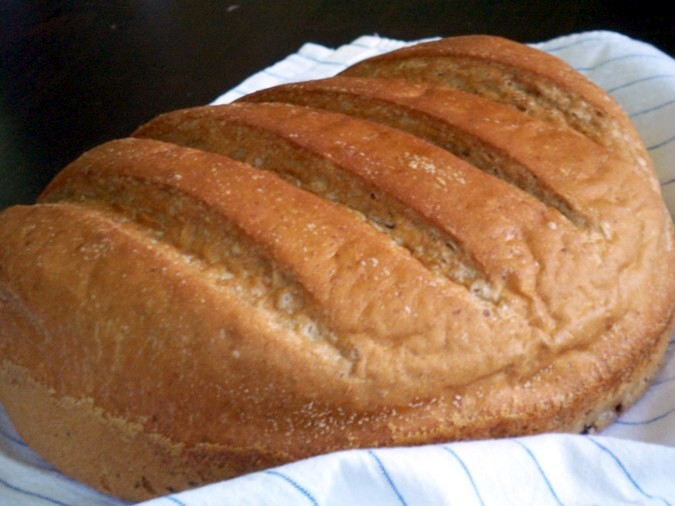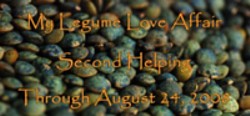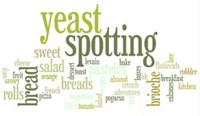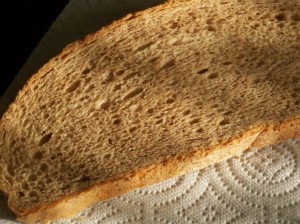Bean Bread
Posted by bakinghistory on August 23, 2008

A pleasant bread with a thin, crispy crust and a tender, moist crumb
 This is my entry for My Legume Love Affair-Second Helping hosted by Susan from The Well-Seasoned Cook
This is my entry for My Legume Love Affair-Second Helping hosted by Susan from The Well-Seasoned Cook
and for
 Yeast Spotting hosted by Susan of Wild Yeast.
Yeast Spotting hosted by Susan of Wild Yeast.
In the vintage cookbooks that I have read I have found that beans are used in bread in two forms: cooked and mashed or as flour. The addition of either was done at times for health reasons (improving the bread nutritional value) and at times for economy.
I recreated the recipe for this bread from one suggested by Eliza Acton in her influential “The English Bread-book: for domestic use”. Miss Acton’s instructions were brief and I added a few details myself. The recipe required “French-beans” which here are usually called navy beans.
I included a little butter and used 50% bread flour and 50% whole wheat flour, to approximate wheatmeal, which was originally called for in the recipe. I did not add any sweetener, but a little brown sugar or honey might be added to taste. I baked the bread in a covered cast iron Dutch oven.
The bread develops a thin, very crispy crust and a fine, moist crumb. The beans do not add much in terms of flavor but provide the moisture for the velvety crumb.
From the original recipe by Eliza Acton
In: “The English Bread-book: For domestic use”, 1857—UK
Ingredients:
For the overnight sponge:
1/8 tsp active dry yeast
250 g (2 cups) white whole wheat flour
150 g warm water
For the dough
1/2 lb cooked navy beans, pureed
250 g (1-3/4 cups) bread flour
2 tbsp brown sugar or honey (optional)
2 tbsp unsalted butter, cold and thinly sliced
9 g fine sea salt
1 tsp active dry yeast
130 g warm water—or as needed
Make the sponge: stir the yeast in the warm water then add the flour and knead briefly until smooth. Shape into a ball place it in a covered glass container and let the sponge ferment overnight in a cool place (12-14 hours).
Make the dough: stir the yeast in half the amount of water, (the sugar or honey if you want) then mix in the pureed beans and finally the sponge cut into small pieces. Mix at low speed for a minute or two, then add the flour and salt and enough of the remaining water to have a dough that is soft and supple. More water or flour might be necessary. Knead at low speed until the gluten is well developed (about 10-15 minutes), and towards the end add the butter, kneading until well incorporated.
Let the dough ferment until doubled in bulk, in a covered bowl. Briefly knead again and let the dough ferment once more until doubled.
Shape the bread and place it in a large cast iron Dutch oven (or clay pot) that you have previously lightly greased and sprinkled with semolina). Preheat the oven to 350F (180C) and once the bread is light score it, sprinkle with water and place the pot (covered) in the oven. Bake for 30 minutes then uncover the pot (carefully!) and let the bread finish baking until golden brown.
Carefully take the pot out of the oven and lift the loaf out —it should be easy, especially if you used a cast iron pot, the bread won’t stick.
Let the bread cool completely on a rack before slicing.






Louise said
What a GREAT rendition of Eliza’s recipe Manuela. I will be passing it on to my daughter, who is always in search of “secret” nutritional bread recipes. It’s quite curious that the beans don not impart their flavor. I’m sure there must be a healthy benefit though. Thanks so very much for sharing…
bakinghistory said
@ Louise: Thanks! 😉 Her bread book is wonderful and full of many great recipes to try. I think that besides the fact that their flavor is rather mild to begin with, in this bread the beans are not detectable because the whole wheat flour provides its own nutty flavor which tends to prevail. But yes, nutritionally the beans are a great addition.
Simona said
How interesting! And the loaf looks very nice.
bakinghistory said
@ Simona: Thanks! I baked it in a cast iron dutch oven (not the enameled kind): it dramatically improves the oven spring and the crust.
deb lee said
can you substitute soy flour for the pureed navy beans?
YeastSpotting August 29, 2008 | Wild Yeast said
[…] Bean Bread ~ Baking History […]
bakinghistory said
@ Deb Lee: As far as I know soy flour should be added in bread dough only in small amounts, or its flavor will prevail (does not taste very good 🙂 ). I would add no more than 1 or 2 tbsp of soy flour to this recipe, use some sweetener (brown sugar or honey) and skip the second rising period, since soy flour makes the dough ripen very fast.
If you eliminate the bean puree you will need to add a little more liquid since they provide a good amount of moisture. You could experiment also with some kind of bean flour: either chickpeas or black beans. etc.